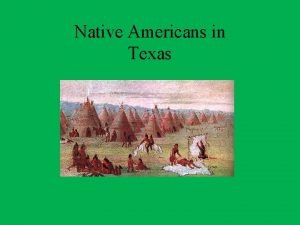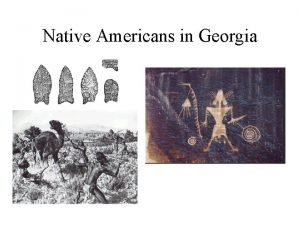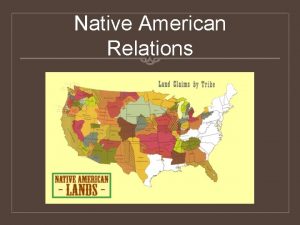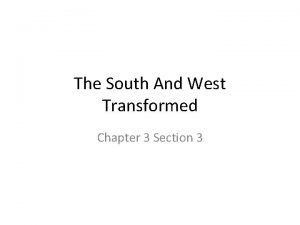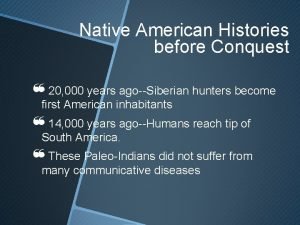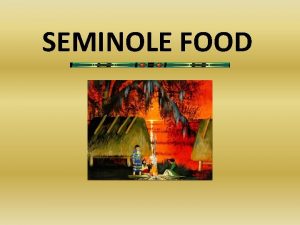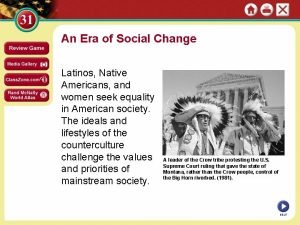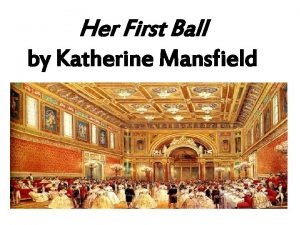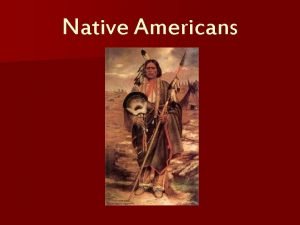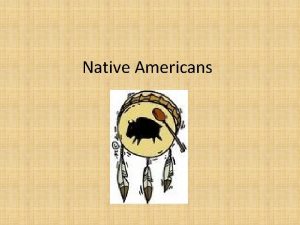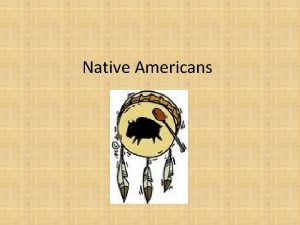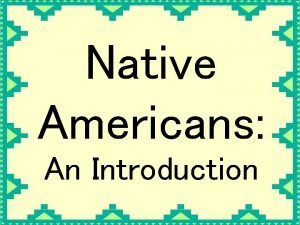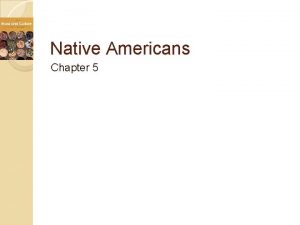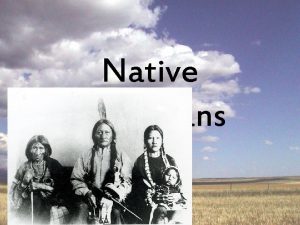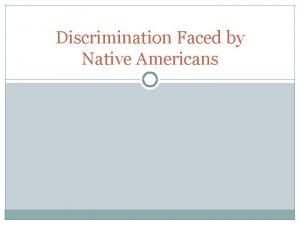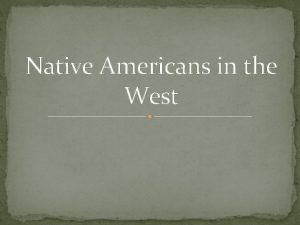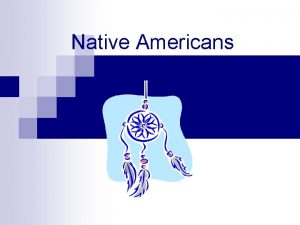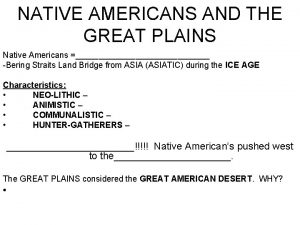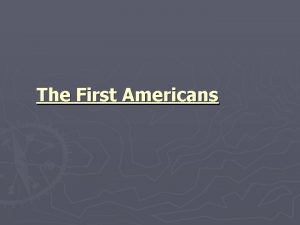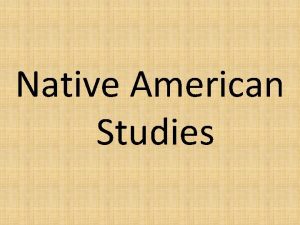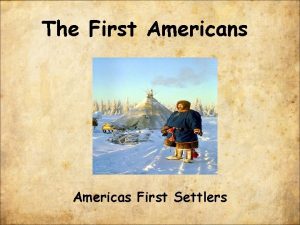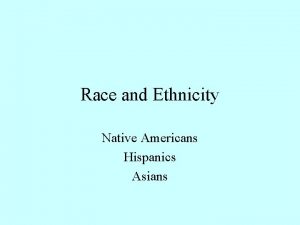The First Americans Themes Origins of Native Americans


















































- Slides: 50

The First Americans

Themes • Origins of Native Americans in Western Hemisphere • Diversity of lifestyle • Changing nature of Indian societies before European contact

Theories of Native Americans & Origins • Numerous theories and beliefs: • Many Anthropologists and Historians agree humans lived in North America since 35, 000 BC • As the Earth began to cool, it is believed that these nomadic people began to migrate. • How did they arrive? ?

Continental Drift • The origin of man can be traced back to places of Africa and Mesopotamia • This nomadic people lacked a way to travel to the Western Hemisphere due to the Continental drift of landmass • Before the drift, scientists believe that all continents were connected, Pangae.

The First Humans • The first human beings appeared in Africa called Homo erectus about million years ago. • More than 1. 5 million years after Homo erectus, modern humans Homo sapiens evolved in Africa • ALL humans are descendants of these ancient Africans.

The First Humans (Migration) • Over a million years, Homo sapiens began to migrate out of Africa and into Europe and Asia • Many of these tribes used rivers and lakes to navigate through the land • They also followed herds and other animals; their food source • Once the Ice Age took place, a land bridge by the name of Beringia made it possible for Homo sapiens to cross over to North America

• Bering Land Bridge • As sea levels dropped because of the earth cooling a land bridge made of ice was formed. • The tribes who migrated followed food and settled in all regions of north and South America.

Siberian Hunters • Siberian hunters roamed Beringia for centuries in search of game animals, grasses and small shrubs. • They hunted mammoths, bison, and numerous smaller animals • As these Siberian hunters migrated more east they became the pioneers of human life in the Western Hemisphere

Paleo-Indians • Archaeologists refer to these Siberian hunters and their decedents as Paleo-Indians. • They arrived in what is now the United States sometime around 15, 000 BP • Paleo-Indians used a distinctively shaped spearhead known as a Clovis point. • Archaeologists have found these artifacts in places surrounding present day New Mexico • These Clovis spears have been dated back to 13, 500 – 13, 000 BP

Paleo-Indians • Around 11, 000 BP, Paleo-Indians encountered a major food shortage due to the extinction of mammoths and other large mammals • Paleo-Indians adapted by hunting smaller animals and devoted more energy to foragingcollecting wild plant foods such as roots, seeds, nuts, berries, and fruits

Archaic Indians • Once the Paleo-Indians changed their ways of survival they began to be called Archaic Hunters and Gatherers • They hunted with spears, but also killed smaller game with traps, nets, and hooks • Used grinding stones to eat seeds • They did not establish permanent villages • Different types of Archaic Indians: Great Plains hunters, Great Basin Indians

Pacific Coast • California peoples remained hunters and gatherers for even hundreds of years after 1492 • The Archaic settlements in California included about 500 separate tribes speaking 90 different languages • Gatherers of berries, fishing

Eastern Woodland Cultures • East of the Mississippi River, Archaic tribes adapted to a forest environment that included river valleys of the Mississippi, Ohio, Tennessee, and Cumberland; the Great Lakes region • Hunted deer for hides and bones • Gathered edible plants, seeds, nuts, pecans, walnuts, and acorns

Southwest Archaic Indians • Present day Arizona, New Mexico, Utah and Colorado developed cultures that were centered around agriculture and dwellings called pueblos • The area was known for having a dry climate and unpredictable floods • Around 3500 BP southwestern hunters and gatherers began to grow corn • They became experts at irrigation by conserving water from streams, springs and rainfall

Different Regions of North America • • Mesoamerica Southwest Eastern Woodlands Pacific Northwest

Regions of Native American Tribes, 1500 A. D. (Mesoamerica)

Farming • One of the important traits influencing the difference between Indian nations was FOOD. • Agricultural Origins - 8000 B. C. Middle East - 5000 B. C. Western Hemisphere - Mesoamerica first in the Americas to establish a farming system.

Major Mesoamerican Cultures ( 1000 B. C. – 1519 A. D. )

Mesoamerican Cultures (Aztecs) • Aztecs (Mexica) migrated from the northwest in the late 13 th Century • Became dominant power by 1325 when small bands settled on an island in Lake Texcoco, future site of Tenochtitlan the capital of the Aztec Empire • By 1430 Forced the people they conquered to pay large tributes. • 300, 000 people lived in the capital city of Tenochtitlan by the 1520 s. More than any other city in Europe at that time.

Mesoamerican Cultures (Aztecs) • The Aztecs worshipped the war god Huitzilopochtli. • Warriors held the most exalted positions in the social hierarchy • Warriors moved up in rank by how many prisoners they captured • Prisoners were then taken to priests who sacrificed them by cutting out their hearts • They believed that blood kept the sun shining

Mesoamerican Cultures (Teotihuacan) • Sun Pyramid, Teotihuacan • An important capital; founded about 300 B. C. • Center for trade and religion • Sun Pyramid was largest construction till the Europeans arrived.

The Great Temple at Tenochtitlan (c. 1519 A. D. )

Aztecs • They honored over 200 deities. • Irrigation network created fertile cropland access to fresh water. • At the time of the Spaniards, the Aztecs were still expanding their Empire into what is now present-day Mexico in the early 1500 s.

Locations of Selected Native American Peoples, 1500 A. D. (Southwest)

Southwest • Known for its dry climate but farming was important • Drought resistant crops were introduced. • Picture are markings made by Anasazi Indians who were once the most powerful tribe in the Southwest.

Anasazi Indians • Between 900 -1150 the Anasazi reached its height. • One community was located near Chaco Canyon which included several towns • The region specialized in processing turquoise. It also became the center for trade since it was located near several roads.

Pueblo Bonito, Chaco Canyon ( Pop. 1200)

Anasazi Indians • Chaco Canyon was an important center for trade. • Anasazi culture declines by 12 th and 13 th centuries as rain levels dropped and tribe succumbed to drought. • Due to no rain the large tribes were forced to dissolve into smaller clans.

Locations of Selected Native American Peoples, 1500 A. D. (Eastern Woodlands)

Eastern Woodlands (Mississippian) • Many tribes lived in this area up until 700 A. D. when Mississippian culture emerged. • Full time farmers and lived in large communities numbering in the thousands. • Largest Mississippian center was Cahokia which was located near present-day St. Louis.

Cahokia Mounds

Cahokia Mounds • Cahokia was located on rich farmland included a very large area. • 124 sq. miles and about 20, 000 residents • Famous for their large platform mounds surrounded by other religious temples and homes for chiefs.

Eastern Woodlands (Mississippian) • After 1200 A. D. Cahokia entered a state of decline. • A change of climate and over taxed environment led to a shortage of food and other resources.

Locations of Selected Native American Peoples, 1500 A. D. (Northeast)

Iroquois: A Confederation of Five Separate Tribes • Located Northeast near present-day Western New York and Pennsylvania • Mohawks • Oneidas • Onondagas • Cayugas • Senecas • In 1600 A. D. they numbered around 10, 000

Who Started the Confederation? • Confederation began before European contact. • Began with the actions of Hiawatha a Mohawk sage in about 1450. • Hiawatha had lost many family members during the constant warfare in the area. • After several days of fasting in the woods Hiawatha received a vision and worked to end internal tribal warfare. • Developed a plan of cooperation among members of confederacy. • This made the Iroquois one of the strongest tribes in America around the time of European contact.

Political Structure • Council Government – Each tribe in the confederacy sent delegates/representatives to council meetings

Iroquois Society • Homes = Longhouses (not very mobile) • 25 ft in width; could range up to 200 ft in length • Several families would live under the roof of one longhouse. • Strong weather resistance living places which included 2 -3 fireplaces to keep families warm during the wintertime. • Food was also stored inside the longhouse.

Iroquois Society • Property was owned communally • No poor families because if one family was struggling the community would help them survive. • Division of labor between men/women: • Men – hunted/fished; warriors • Women – farmed and gathered

Women in Iroquois Society • Descent was matrilineal; longhouses were headed by women. • Children traced their ancestry through their mothers not their fathers. . • Women could divorce their husbands • Women selected all delegates to the Iroquois Council and influenced policy.

Locations of Selected Native American Peoples, 1500 A. D. (New England)

New England Indians Northern New England • Vermont, New Hampshire, Maine • Hunter-gathers: VERY mobile • Did not farm • Spring and summer lived near coast; moved in for fall and winter to hunt game animals. • 15, 000 -20, 000 population in 1600. Southern New England • Massachusetts, Connecticut, Rhode Island • Hunted AND farmed (at times up to 2/3 of diet ) • Allowed them to store foods to avoid starving time like their neighbors to the north. • 55, 000 -80, 000 population in 1600.

Farming Methods • Fields were cleared by girdling and with fire • “Three Sisters” of agriculture - Corn, beans, and squash were planted together • Farming had a major impact on the environment.

Locations of Selected Native American Peoples, 1500 A. D. (Pacific Northwest)

Pacific Northwest Indians • Southern Alaska spreading along the west coast of British Colombia in both Washington and Oregon up until Northern California. • Lived as hunter/gathers, but also incredibly wealthy. • Most Indian tribes that were hunter/gathers usually had food shortages. However, pacific northwest Indians had an abundance of food supply in the area.

Pacific Northwest Indians (Cedar) • Cedar trees could reach 250 feet height and 18 feet in diameter. • Bark: used for clothing, baskets, etc. - when softened it could be fashioned into diapers for babies. • Lumber: canoes, homes (longhouses), etc. - Longhouses were very large: 100 x 40 ft.

Indians of the Pacific Northwest (Seafood/Salmon) • Seafood was the foundation of their diet; particularly salmon. • Fish could be caught many ways • Fish were preserved by drying and smoking. • Key – Abundance - Clams, crabs, and other shellfish were eaten. - Whales were hunted in some areas.

Pacific Northwest Indians (Society) • Society was VERY highly stratified • Two Classes of people: 1. Slaves 2. Free - Their rank was determined primarily by wealth. In some cases, occupation influenced rank.

Rank in Society • Free men and women – Top Most Wealth • Bottom – Least Wealth • Slaves – no rank

Review • Origins of Native Americans • Tremendous differences among Indian people • Compare and contrast life; what were some important traits of people living in different regions?
 Coahuiltecan tattoos
Coahuiltecan tattoos Where did native americans come from
Where did native americans come from How many native americans died on the trail of tears
How many native americans died on the trail of tears What three circumstances hurt native americans
What three circumstances hurt native americans Native americans
Native americans Seminole tribe food
Seminole tribe food Latinos and native americans seek equality
Latinos and native americans seek equality Hình ảnh bộ gõ cơ thể búng tay
Hình ảnh bộ gõ cơ thể búng tay Bổ thể
Bổ thể Tỉ lệ cơ thể trẻ em
Tỉ lệ cơ thể trẻ em Voi kéo gỗ như thế nào
Voi kéo gỗ như thế nào Chụp tư thế worms-breton
Chụp tư thế worms-breton Alleluia hat len nguoi oi
Alleluia hat len nguoi oi Các môn thể thao bắt đầu bằng tiếng chạy
Các môn thể thao bắt đầu bằng tiếng chạy Thế nào là hệ số cao nhất
Thế nào là hệ số cao nhất Các châu lục và đại dương trên thế giới
Các châu lục và đại dương trên thế giới Công thức tiính động năng
Công thức tiính động năng Trời xanh đây là của chúng ta thể thơ
Trời xanh đây là của chúng ta thể thơ Mật thư anh em như thể tay chân
Mật thư anh em như thể tay chân Làm thế nào để 102-1=99
Làm thế nào để 102-1=99 Phản ứng thế ankan
Phản ứng thế ankan Các châu lục và đại dương trên thế giới
Các châu lục và đại dương trên thế giới Thể thơ truyền thống
Thể thơ truyền thống Quá trình desamine hóa có thể tạo ra
Quá trình desamine hóa có thể tạo ra Một số thể thơ truyền thống
Một số thể thơ truyền thống Bàn tay mà dây bẩn
Bàn tay mà dây bẩn Vẽ hình chiếu vuông góc của vật thể sau
Vẽ hình chiếu vuông góc của vật thể sau Thế nào là sự mỏi cơ
Thế nào là sự mỏi cơ đặc điểm cơ thể của người tối cổ
đặc điểm cơ thể của người tối cổ V. c c
V. c c Vẽ hình chiếu đứng bằng cạnh của vật thể
Vẽ hình chiếu đứng bằng cạnh của vật thể Tia chieu sa te
Tia chieu sa te Thẻ vin
Thẻ vin đại từ thay thế
đại từ thay thế điện thế nghỉ
điện thế nghỉ Tư thế ngồi viết
Tư thế ngồi viết Diễn thế sinh thái là
Diễn thế sinh thái là Dạng đột biến một nhiễm là
Dạng đột biến một nhiễm là Số nguyên tố là
Số nguyên tố là Tư thế ngồi viết
Tư thế ngồi viết Lời thề hippocrates
Lời thề hippocrates Thiếu nhi thế giới liên hoan
Thiếu nhi thế giới liên hoan ưu thế lai là gì
ưu thế lai là gì Sự nuôi và dạy con của hổ
Sự nuôi và dạy con của hổ Khi nào hổ con có thể sống độc lập
Khi nào hổ con có thể sống độc lập Hệ hô hấp
Hệ hô hấp Từ ngữ thể hiện lòng nhân hậu
Từ ngữ thể hiện lòng nhân hậu Thế nào là mạng điện lắp đặt kiểu nổi
Thế nào là mạng điện lắp đặt kiểu nổi Her first ball katherine mansfield themes
Her first ball katherine mansfield themes Origins of sociology
Origins of sociology
